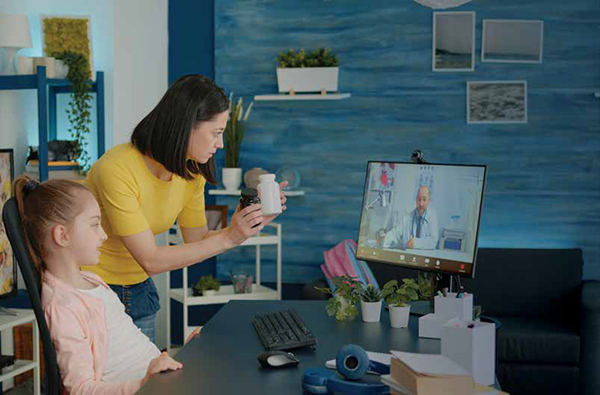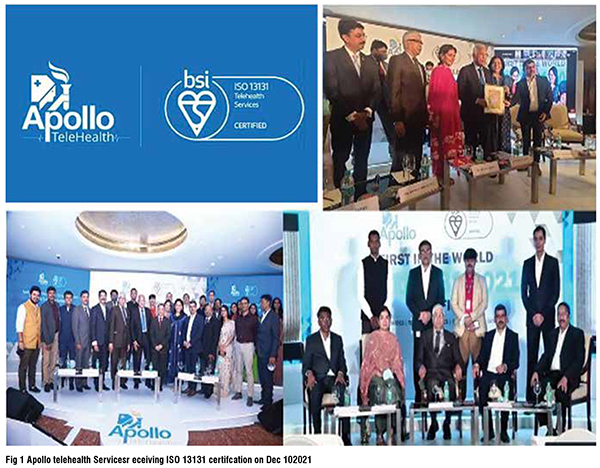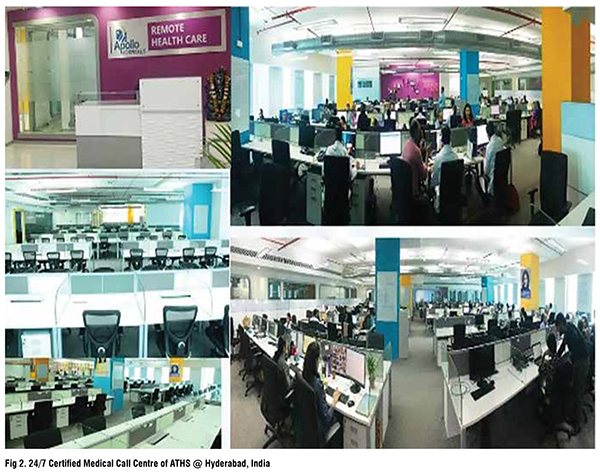
With Telehealth now becoming an integral component of the healthcare delivery system, maintaining high quality, with systems and processes, in a future ready technology enabled Remote Healthcare milieu becomes mandatory. This article will highlight the challenges faced and overcome to obtain a global ISO 13131 Certification exclusively for Telehealth Services and its implications.

With telehealth now becoming an integral component of the healthcare delivery system, maintaining high quality, with systems and processes, in a future ready, technology-enabled remote healthcare milieu becomes mandatory. With geography becoming history, distance has become meaningless. Various stakeholders with diversified backgrounds constitute the telehealth eco system. Cultural and socioeconomic differences notwithstanding, it is essential that the whole world talks in the same language, as far as actual deployment of telehealth is concerned. Formulating dynamic standards implies seeing the Big Picture and understanding the nitty gritty as well The global ISO 13131 Certification exclusively for telehealth Services fulfils these objectives.
For decades, Telemedicine/telehealth services were not centre stage in the healthcare deliverysystem. Covid -19 changed this. The world has now accepted that the original forced lockdown- enforced acceptance of Remote Health Care will become the new normal even after the pandemic is de notified. Universal acceptance increases the responsibility of all healthcare providers deploying technology to ensure constant high quality while bridging the urban-rural health divide.
Quality is never an accident. It is always the result of sincere effort, intelligent direction, and skilful execution. Henry Ford opined that quality means doing it right when no one is looking, but in the real world this is difficult to implement. ISO certification ensures that “Big Brother” is watching all the time. The necessity for re-certification is like the Sword of Damocles hanging above us. It drives home the message that quality is everyone’s responsibility at all times and not during the audit alone. One has to keep running to stay where one is. To maintain the initial global recognition, maintaining quality needs to become a habit, a unique opportunity to transform one’s DNA if necessary. Success is the sum of small efforts, repeated day-in and day-out. Standardising systems, processes, documentation and re-documentation alone will ensure providing quality remote healthcare for anyone, anytime anywhere..
The International Standards Organization (ISO), TC 215 Health Informatics Committee, developed a Technical Specification, ISO/TS 13131 Telehealth Services, based on a risk and quality management approach. This standard supports healthcare planning, service and workforce planning, organisation responsibilities and financial and IT management. ISO was established in 1947 in Geneva, Switzerland. An Independent, non-governmental international organisation, ISO develops standards that are recognised and respected globally. It brings experts together to improve quality and provide worldclass healthcare services. Experts are from 166 national standard bodies. ISO standards are developed by various advisory groups. Presently ISO has 255 technical committees, 515 subcommittees, and 2498 working bodies. Since 1947, ISO's technical experts have created more than 18,800 standards for all possible business. ISO standards ensure that administration and product/work flow systems are carried out legally, safely and effectively. ISO technical experts have developed several assessment protocols to ensure that certified organisations apply these guidelines in their workplace. The approved protocols aid organisations to ensure that their frameworks, devices and workforce comply with ISO standards. ISO 13131 provides recommendations on guidelines for telehealth services deploying Information and Communication Technology (ICT) to deliver quality healthcare services.
Implementing ISO/TS 13131 means facilitating cooperation and interoperability of its different health systems to ensure quality telehealth services. It also ensures a reliably high standard of service, irrespective of where a person lives, across the globe. This standard provides guidelines for developing quality plans and managing company resources, while putting the right policies in place to safeguard clients’ private data. Securing ISO 9001 for quality management and ISO 27001 for information security management reduces the complexity involved in getting the IOSO 13131 branding.
The decision to get a time consuming, labor-intensive and expensive certification is the determination to set a benchmark in the telehealth sector. If a leading market player faces competition, the company needs reassurance that its high-quality standards would provide a stamp of recognition distinguishing it, from its competitors. Pioneers in the field, set conditions of competition, to prevent some potentially harmful practices of others, from compromising the reputation of all. Considering risks involved in securing patients’ data privacy, IT systems and processes need to be stringent conforming to security legislation. A preliminary gap analysis is initially conducted and deficits if any addressed, to fulfil specific criteria required for ISO/TS 13131. Beneficiaries draw confidence from a stringent certification process. ISO standards help organisations comply with new regulatory requirements, enhancing efficiency of internal processes and quality of remote health services provided. Documenting the much needed framework necessary for supply of services, improves value of the product. The more diverse and competitive the market, the more guidance consumers need, to ensure they are purchasing an excellent cost effective service. International Standards helps maintain a healthy competition in the marketplace.


Right quality metrics are identified. This information is made available to patients, health systems and providers. Consumers are helped to gauge telehealth providers. Healthcare workers and systems need feedback for continuous improvement. Best practices for virtual care need to be standardised, notified and applauded so that it will be increasingly sought. With the pandemic disrupting in-person care, virtual healthcare needs to be prioritised. The time to define, implement and enforce quality in all aspects of telehealth is not tomorrow but today. Formal certification by an international organisation requires hundred percent fulfilment of stringent criteria . This pre supposes commitment of a very high order and the realisation that excellence is always a moving target. One can never ever rest on one’s laurels. We need to keep running to stay where we are.
ISO / TS 13131 is based on a risk and quality management approach allowing a broader approach to generate detailed guidelines required by a particular service. The class of standards provide flexible, general guidelines supporting innovation in healthcare. These include financial management and service, workforce and healthcare planning in addition to healthcare organisation responsibilities, facilities, technology, and information management. All existing national and international standards including standards for safety, quality and risk in health are evaluated. Standards overcome barriers in knowledge sharing. Community interest is promoted ahead of sectional interests. Often local needs, conflicting business models, intellectual property and policies have to be balanced against national and global interests. Specific guidelines including technical standards are available for clinical specialties using telehealth. However, these are at the most national. Global Standards add credibility, standardise approaches and decrease liabilities. Guidelines in the ISO/TS 13131 specification are designed to support telehealth services offered by a healthcare organisation and healthcare professionals. The specification is used as a tool customised for each healthcare setting. The healthcare professional or healthcare third party is required to possess competencies necessary for providing healthcare remotely. Appropriate minimum professional standards are applied in assessment of required competencies.
These specifically deal with financial, facilities, operations, technology, and information management, service and technical support, service delivery and infrastructure deployment. The ISO/TS 13131 specification provides useful guidelines to assist the development of telehealth services, but it remains the job of each organisation to develop appropriate guidelines for each health service. Transitioning from face to-face delivery of health services to telehealth requires managing safety and quality in a virtual environment.
Proof of quality is a precondition requested by principals, prior to placing an order. Quality of services/products is important in all services provided by organisations. Quality should conform with requirements defined by customers.Better the service quality more the utilisation. In telehealth the focal point is always the patient. Comprehensive information about content of services provided, formal authorisation before transfer of confidential patient data to a third party and regular customer satisfaction surveys are key requirements of a QMS.Third party auditing and certification of the system, give a measurable value. Safeguarding legal compliance with priority on data safety, cost effectiveness, involvement of employees and customer satisfaction are key ingredients to fulfil needs of all stakeholders in tele-monitoring applications.
Key Requirements for ISO 13131 Certification for telehealth Services
• Management of all telehealth processes by the healthcare organisation
• Management of financial resources to support telehealth services
• Processes relating to staff responsibilities
• Provision of infrastructure facility for telehealth service organisations
• Management of Information and Technology resources used in telehealth services
Guidelines in ISO/TS 13131
• Service planning ensures that appropriate, accessible and quality healthcare services are provided to patients.
• Workforce planning ensures that managers, clinical and technical staff are qualified and skilled to provide safe and high quality services.
• Healthcare planning includes planning, designing and implementation of processes, clinical and technical guidelines, risk management and medical record management.
• Responsibilities of Stakeholders: Key stakeholders in the telehealth system (Healthcare providers and beneficiaries) should be competent to use technologies associated with telehealth services. Organization is responsible to provide safe and quality services.
Safety and quality risks in the use of telehealth
• Financial management is required to provide sufficient funding for telehealth services.
• Facilities management must ensure that adequate facilities are provided in telehealth services, including infrastructure and technical devices.
• Technology management ensures that telehealth services are equipped with ICT to deliver quality healthcare. Transmitting healthcare information and procedures relating to data security and data privacy are also equally important
Guidelines and standards for telehealth is an important and valuable process to help ensure effective and safe delivery of quality healthcare. Evidence is needed to validate existing guidelines and guide revision of future versions. There is evidence supporting telehealth’s utility and benefits. However there are differences in approaches and norms for conducting telehealth. Stakeholders include clinicians, medical support and technical staff. CEOs, business development and other managers also form part of the team. In any field, improving performance and accountability depends on having a shared goal that unites the interests and activities of all stakeholders.
ISO/TS 13131 is an example of how ICTs can improve society by facilitating the distribution of services. Human services are not replaced. It is complemented and enhanced by codifying and formalizing best practices in quality healthcare and patient safety. ISO 13131ensures interoperability of different health systems ensuring a high standard of service no matter where a person lives, across the globe. Guidelines ensure managing company resources, using right policies to safeguard clients’ private data.
KNOWLEDGE: Improper knowledge about ISO standards and compliance is a common problem. It is essential that the company knows their current state, what is to be achieved and processes to bridge the gap.
MANAGEMENT COMMITMENT: Management's commitment to achieve ISO compliance is critical including clear understanding of benefits of ISO certification - from delivering quality service to improving business efficiency. A committed management will result in effective implementation of ISO resulting in a culture of continuous improvement.
EMPLOYEE MOTIVATION: ISO implementation drive is never easy on employees. It is difficult to initiate if there is resistance. The latter is due to lack of knowledge about ISO. This is eliminated/reduced through training sessions.
AUDITING PROCESS: Internal audit report is mandatory for ISO certification. Audit identifies areas where there is scope for improvement. Inexperience in performing internal audits is a major challenge in ISO standards implementations.
FINANCIAL SUPPORT: Lack of funds makes implementing ISO standards difficult . Funds are required to train the staff, purchase high quality equipments if required, payments to auditors, external consultants and to procure certification. The organisation needs to ensure that all required costs are pre calculated and have been accounted for, before the compliance process
So what does the future hold for ISO/TS 13131 ICT is being used in everyday healthcare through texts, e-mails and smartphone-enabled videos. It is expected that there will be an extension and intensification of their use in general practice and hospitals to manage patient health. ICT is developing at a breakneck pace. Wireless broadband Internet access, and 5G will be the gold standard sooner than later. Regulations in their application to telehealth will be tightened. ISO standards will help all players in the eco system to talk and understand the same language. Enhancing efficiency of internal processes will lead to improvement in quality of health services provided remotely . Preparation for a global certification helps improve quality of services offered and reassures patients that they are getting better than the best. Realising that excellence is always a moving target it is logical next step in a company’s journey to go (to paraphrase Captain Kirk of Star Trek) “where no Man had ever gone before”. On December 10th 2021 the ISO 13131 -2021, certification for telehealth services was obtained for the first time, anywhere, by Apollo Telehealth Services. It is the author’s belief that raising the bar and setting high standards is more important than following standards. One day the world will strive to achieve India class!